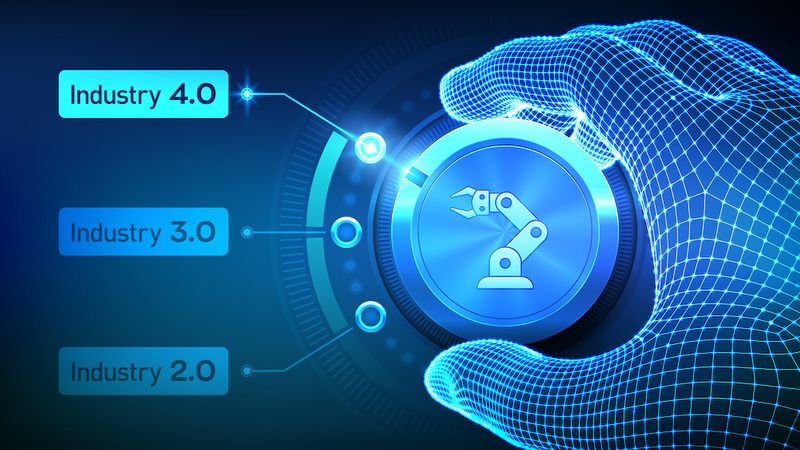How Industrial IoT and ML are powering Industry 4.0
The Industrial Revolution began in Britain sometime around 1760. It ushered in a period where coal-fired steam engines powered increased mechanization and productivity and transformed a largely agrarian society into a manufacturing one.
This article was first published on
blog.nordicsemi.comThe Industrial Revolution began in Britain sometime around 1760. It ushered in a period where coal-fired steam engines powered increased mechanization and productivity and transformed a largely agrarian society into a manufacturing one.
Things dramatically accelerated again in the 1870s as machine tools, the Bessemer steel-making process, the telegraph, electrification, the internal combustion engine and widespread availability of oil and gas supercharged industry. Then, in the late 1960s, the third era of industrial disruption began, thanks to the emergence of digital computers. This allowed for computer-aided design (CAD), consistent manufacture of complex components, greater automation and higher productivity.
Industry 4.0 in full swing
Now we find ourselves in the midst of “Industry 4.0”. This is characterized by the large-scale automation of traditional manufacturing and industrial practices, smart technology, widespread machine-to-machine communication (M2M) and the transformative power of machine learning (ML). The key difference between Industry 3.0 and 4.0 is that, while digital information is key to both, in the former case, it is used by humans to make better decisions, while Industry 4.0 uses the same information (and more besides) to optimize things largely without human intervention.
The ‘Industrial’ Internet of Things (IIoT) is at the heart of this new manufacturing and production phase. It is the platform through which automation, M2M, and ML are supported. The IIoT uses feedback loops whereby sensors monitor processes, and their data is then used to control, refine and refine machine operation.
The importance of precision
Optimization is important because manufacturing relies on precision and repeatability. A car component, for example, must be manufactured to tolerances tight enough such that the product can be bolted to any of thousands of examples of a particular model and work perfectly every time for many years. The smaller and more delicate the manufactured items are – think of the mechanism of a fine watch, the windings of a tiny electric motor or the soldering in a smartphone – –the greater the precision required during manufacturing.
Getting products right the first time reduces potential field failures and expensive warranty claims. It also saves large amounts of resources and money, especially if components are made from exotic materials or by machine tools that are expensive to purchase and run. It is also more environmentally friendly to make things correctly the first time as it saves the energy and carbon emissions it takes to produce new items to replace the defects.
The use of ML in manufacturing
The key to ensuring precision time and time again is process control. Sensors and cameras can monitor machines, measure finished parts to pick up any minor deviations in the product, and correct the process before things drift out of tolerance. Beyond the manufacturing process itself, many other factors can compromise a process, so other sensors keep track of things like vibration, temperature, humidity and air quality.
But a continuous and large-scale manufacturing process will generate a lot of sensor data. And much of that data will show little change. Transmitting and analyzing huge volumes of data is time consuming, costly and uses a lot of energy. Instead, sensors are now starting to incorporate onboard edge processing and ML to learn how to spot significant trends in an otherwise unchanging stream of data. When trends are detected, the information is sent to the coud for analysis and action.
ML can also help to pre-empt issues that might arise due to external factors – for instance, an increase in humidity caused by workers arriving for the day, air flow from open windows and doors, and changes in temperature throughout the day and night. Using this information, processes can be tuned ahead of any potential problems.
Linking the front office and the factory floor
The IIoT is not only changing the way products are made but also how they’re designed. Industry 3.0 made full use of computers, but those doing the design work and those doing the manufacturing didn't talk to each other. Engineers would take CAD outputs from the design office and use the information to program the machine tools manually. Apart from being labor-intensive and prone to error, it also missed the chance to refine the design to make it easier, cheaper, and quicker to make.
Industry 4.0 links the front office to the factory floor. Using M2M communications, design computers can talk to machine tools to directly program them to make parts. And machine tools can speak to design computers to let them know where the bottlenecks are in the manufacturing process such that products can be redesigned for simpler manufacture without compromising function. And a centralized computer can take all the design and manufacturing data to work out the best way to make future products that are long-lasting, able to be repaired, and, at the end of their lives, easily recyclable.
The IIoT will usher in industry 5.0
Investing in the IIoT is expensive. However, wireless technology does cut the cost of installing wiring and makes it easy to reconfigure networks as the factory changes and expands. And the long-term savings brought by better design and manufacture are significant as productivity increases and product failures decline.
Industry 4.0 is here and the vision for Industry 5.0 is clear. That vision is sustainability. According to the EU, the next leap will take industry “beyond efficiency and productivity as the sole goals, and reinforces the role and the contribution of industry to society while, crucially, respecting the production limits of the planet.” That is a laudable objective but a huge challenge. But it’s one that the IIoT will help us solve.
This article was first published on Nordic's Get Connected Blog.
